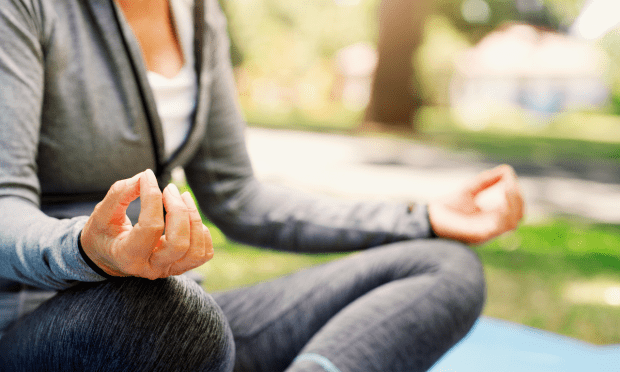In the fast-paced and chaotic world we live in, finding out how to clear your mind can be a challenge. However, mastering the art of mindfulness can be the key to unlocking a happier and healthier life.
Mindfulness is the practice of intentionally focusing on the present moment, without judgment, and cultivating a deep awareness of our thoughts, emotions, and surroundings. By clearing our minds of distractions and becoming fully present, we can reduce stress, improve our mental well-being, and enhance our overall quality of life.
In this article, we will explore the benefits of mindfulness and provide practical tips and techniques to incorporate this powerful practice into your daily routine. Whether you’re a busy professional, a stressed-out student, or simply seeking a more peaceful existence, this guide will help you embrace the art of mindfulness and discover the transformative impact it can have on your life.

The 5 Second Rule
by Mel Robbins
⏱ 11 minutes reading time
🎧 Audio version available
What is mindfulness?
Mindfulness is the art of being fully present in the moment, without judgment or attachment to our thoughts or emotions. It is the practice of intentionally bringing our attention to the here and now, rather than dwelling on the past or worrying about the future.
In today’s hyperconnected world, our minds are often scattered, jumping from one thought to another, and constantly bombarded by external distractions. Mindfulness offers a way to calm the noise and find inner peace.
To cultivate mindfulness, we must learn to observe our thoughts and feelings without getting caught up in them. It involves developing a sense of curiosity and non-judgmental awareness towards our experiences. By doing so, we can gain a deeper understanding of ourselves and the world around us.
Mindfulness is not about emptying the mind or suppressing thoughts; it’s about acknowledging them and letting them pass without getting entangled in them. It’s about being fully engaged in the present moment, no matter how simple or mundane it may seem.
The benefits of practicing mindfulness
The practice of mindfulness offers numerous benefits for our mental, emotional, and physical well-being. Research has shown that regular mindfulness practice can reduce stress, anxiety, and depression. It can improve our ability to cope with difficult emotions and enhance our overall resilience.
By cultivating mindfulness, we can develop a greater sense of self-awareness and a deeper connection with our own thoughts, feelings, and values.
One of the key benefits of mindfulness is its ability to enhance our focus and concentration. In today’s digital age, where distractions are constantly pulling us in different directions, the ability to stay focused and engaged has become a valuable skill. Mindfulness can help us train our minds to stay present and fully engaged in the task at hand, leading to increased productivity and better performance in our daily lives.
Furthermore, mindfulness has been shown to improve our relationships and communication skills. When we are fully present with others, without judgment or distraction, we can truly listen and empathize. This deep level of presence and connection can foster better understanding, trust, and intimacy in our relationships.
Scientific research on mindfulness and its effects
Over the past few decades, there has been a growing body of scientific research on mindfulness and its effects on the brain and body. Neuroscientists have used brain imaging techniques to study the impact of mindfulness on brain structure and function.
These studies have shown that regular mindfulness practice can lead to changes in the brain’s structure, particularly in areas associated with attention, emotional regulation, and empathy.
Research has also found that mindfulness can have a positive impact on our physical health. Studies have shown that mindfulness-based interventions can reduce blood pressure, improve immune function, and even help with chronic pain management. By reducing stress and promoting relaxation, mindfulness can have a profound effect on our overall well-being.
How to practice mindfulness in everyday life
Incorporating mindfulness into our daily lives doesn’t have to be complicated or time-consuming. It can be as simple as taking a few minutes each day to pause, breathe, and bring our attention to the present moment. Here are some practical tips and techniques to help you cultivate mindfulness in your everyday life:
- Mindful breathing: Take a few moments to focus on your breath. Notice the sensation of the breath as it enters and leaves your body. If your mind starts to wander, gently bring your attention back to the breath.
- Body scan: Close your eyes and bring your attention to different parts of your body, starting from the top of your head and slowly moving down to your toes. Notice any sensations or areas of tension without judgment, and allow them to relax.
- Mindful eating: Before you eat, take a moment to appreciate the smell, texture, and color of the food. Chew slowly and savor each bite, noticing the flavors and sensations in your mouth.
- Walking meditation: Take a walk in nature and pay attention to the sights, sounds, and sensations around you. Focus on the rhythm of your steps and the feeling of the ground beneath your feet.
- Mindful listening: When someone is speaking to you, give them your full attention. Put aside any distractions and truly listen to what they are saying, without interrupting or formulating a response in your mind.
Mindfulness techniques for stress reduction
Stress has become a common part of our daily lives, but mindfulness can be a powerful tool for managing and reducing stress. Here are some mindfulness techniques that can help you find calm and restore balance in stressful situations:
- Mindful breathing: Take a few deep breaths, focusing on the sensation of the breath as it enters and leaves your body. Notice any tension or tightness in your body, and allow it to release as you exhale.
- Body scan: Close your eyes and bring your attention to any areas of tension or discomfort in your body. Imagine sending your breath to those areas, allowing them to relax and soften.
- Mindful acceptance: Instead of resisting or fighting against stressful thoughts or emotions, practice accepting them as they are. Allow yourself to feel whatever arises, without judgment or attachment.
- Mindful movement: Engage in gentle physical activity, such as yoga or tai chi, that combines movement with mindfulness. Pay attention to the sensations in your body as you move, and let go of any tension or stress.
- Mindful self-compassion: Treat yourself with kindness and compassion, especially during times of stress. Practice self-care activities that nourish your body and mind, such as taking a warm bath, reading a book, or practicing a hobby you enjoy.
Mindfulness exercises for improved mental clarity
In addition to reducing stress, mindfulness can also improve our mental clarity and focus. Here are some mindfulness exercises that can help sharpen your mind and enhance your cognitive abilities:
- Focused attention: Choose an object or task to focus your attention on, such as a candle flame or a specific word. Whenever your mind starts to wander, gently bring your attention back to the object or task.
- Mindful observation: Take a few moments to observe your surroundings, paying attention to the details of your environment. Notice the colors, shapes, and textures around you, without labeling or judging them.
- Mindful reading: When reading a book or an article, bring your full attention to the words on the page. Notice the meaning and emotions conveyed by the author, and allow yourself to become fully absorbed in the text.
- Mindful creativity: Engage in a creative activity, such as drawing, painting, or writing, with a sense of mindfulness. Focus on the process rather than the outcome, and allow your creativity to flow without judgment or self-criticism.
- Mindful reflection: Take a few moments each day to reflect on your thoughts, emotions, and experiences. Write them down in a journal, without censoring or editing. This practice can help you gain insights and develop a deeper understanding of yourself.
Mindfulness and its impact on physical health
The practice of mindfulness not only benefits our mental and emotional well-being but also has a positive impact on our physical health. Research has shown that mindfulness-based interventions can be effective in managing various physical health conditions. Here are some ways mindfulness can improve your physical well-being:
- Stress reduction: Chronic stress has been linked to numerous health problems, including heart disease, obesity, and gastrointestinal disorders. By reducing stress, mindfulness can help protect against these conditions and promote overall health.
- Pain management: Mindfulness-based interventions have been shown to be effective in reducing chronic pain. By bringing our attention to the present moment and accepting pain without resistance, we can change our relationship with pain and experience relief.
- Improved sleep: Mindfulness can help improve the quality of our sleep by reducing stress and promoting relaxation. By practicing mindfulness before bed, we can calm our minds and create a peaceful environment for sleep.
- Enhanced immune function: Chronic stress can weaken our immune system, making us more susceptible to illnesses and infections. Mindfulness has been shown to strengthen the immune system and improve immune function, leading to better overall health.
Mindfulness apps and resources for beginners
If you’re new to mindfulness, there are numerous apps and resources available to help you get started. Here are some popular mindfulness apps that can guide you in your practice:
- Headspace: This app offers guided meditations, sleep sounds, and mindfulness exercises tailored to your needs and goals. It provides a structured program to help you develop a regular mindfulness practice.
- Calm: Calm offers guided meditations, sleep stories, and relaxing music to help you unwind and find inner peace. It also provides breathing exercises and mindfulness tools for stress reduction.
- Insight Timer: With a vast library of guided meditations and mindfulness courses, Insight Timer offers something for everyone. You can choose from different teachers, styles, and lengths of meditations to suit your preferences.
- Stop, Breathe & Think: This app allows you to check in with your emotions and provides personalized mindfulness recommendations based on how you’re feeling. It offers a wide range of guided meditations and mindfulness exercises for different situations.
Related: The Art of Simplicity: Unlocking Happiness through Minimalism and Mindfulness
Incorporating mindfulness into your daily routine
To fully embrace the art of mindfulness, it’s important to make it a part of your daily routine. Here are some tips for incorporating mindfulness into your daily life:
- Start small: Begin with just a few minutes of mindfulness practice each day and gradually increase the duration as you become more comfortable. Consistency is key, so aim for daily practice, even if it’s just for a few minutes.
- Find moments of stillness: Look for opportunities throughout the day to pause and bring your attention to the present moment. It could be while waiting in line, during a break at work, or before going to bed. Use these moments to check in with yourself and cultivate mindfulness.
- Create reminders: Set reminders on your phone or place visual cues around your environment to remind yourself to practice mindfulness. It could be a sticky note on your desk, a reminder on your phone, or a mindfulness bell that rings at regular intervals.
- Integrate mindfulness into daily activities: Find ways to bring mindfulness into everyday activities, such as brushing your teeth, washing dishes, or taking a shower. Pay attention to the sensations, smells, and movements involved in these activities, and allow yourself to fully experience them.
- Practice self-compassion: Be patient and kind to yourself as you embark on your mindfulness journey. It’s natural for your mind to wander and for challenges to arise along the way. Treat yourself with compassion and remember that mindfulness is a lifelong practice.
Conclusion: Embracing mindfulness for a happier, healthier life
In conclusion, the art of mindfulness offers a powerful tool for finding peace and clarity in our fast-paced and chaotic world. By intentionally focusing on the present moment and cultivating a deep awareness of our thoughts, emotions, and surroundings, we can reduce stress, improve our mental well-being, and enhance our overall quality of life.
Whether you’re a busy professional, a stressed-out student, or simply seeking a more peaceful existence, embracing mindfulness can have a transformative impact on your life. So take a deep breath, clear your mind, and embark on a journey of self-discovery and self-compassion. Embrace the art of mindfulness and unlock a happier, healthier life.
What Is Snapreads?

With the Snapreads app, you get the key insights from the best nonfiction books in minutes, not hours or days. Our experts transform these books into quick, memorable, easy-to-understand insights you can read when you have the time or listen to them on the go.



